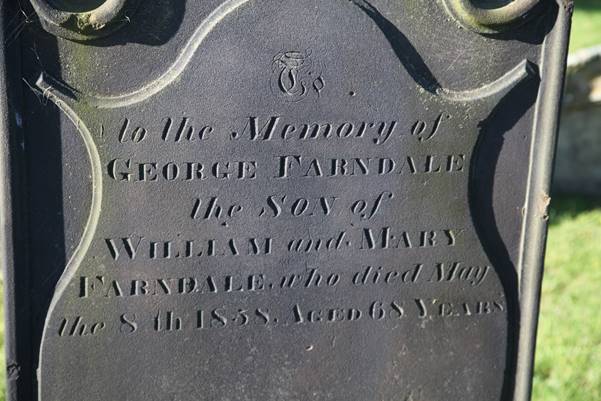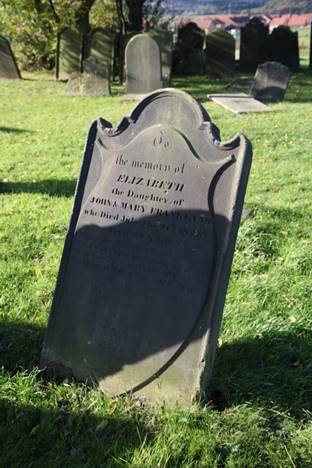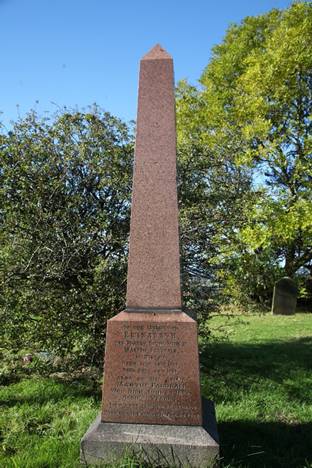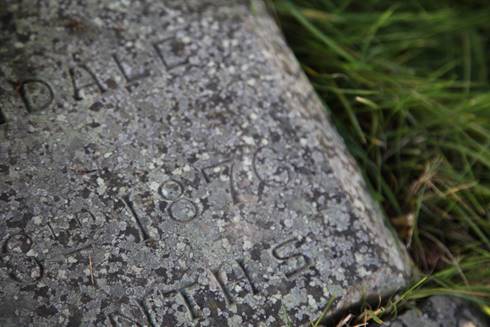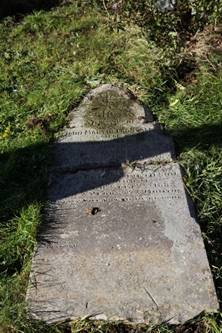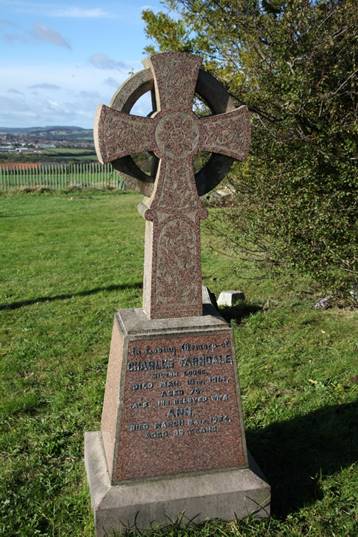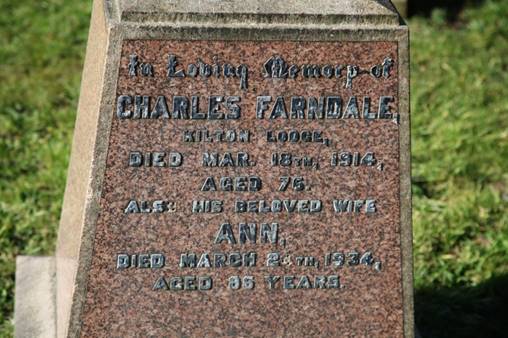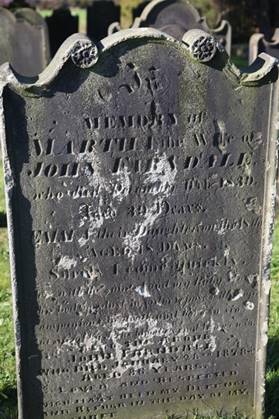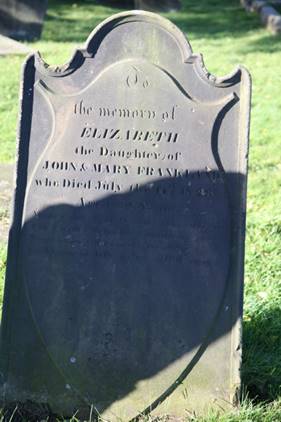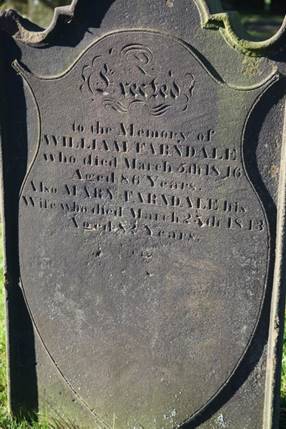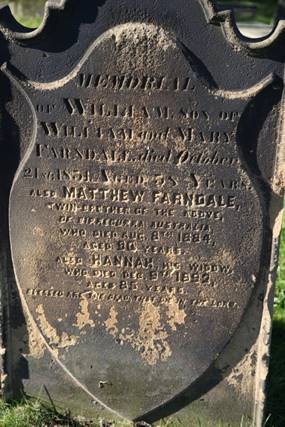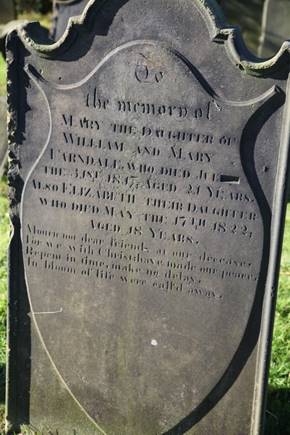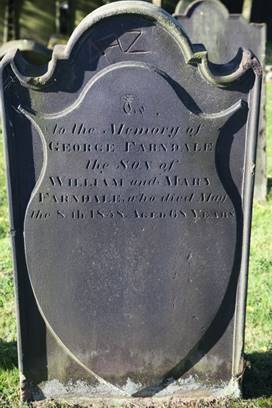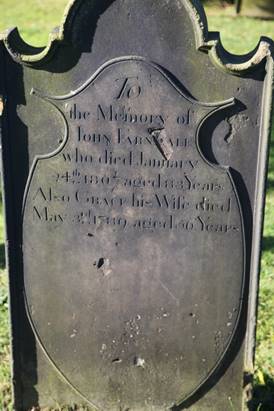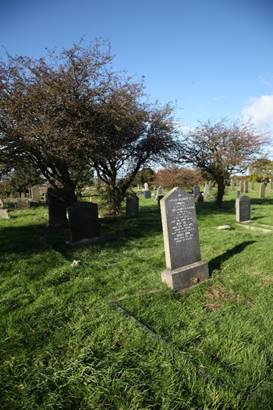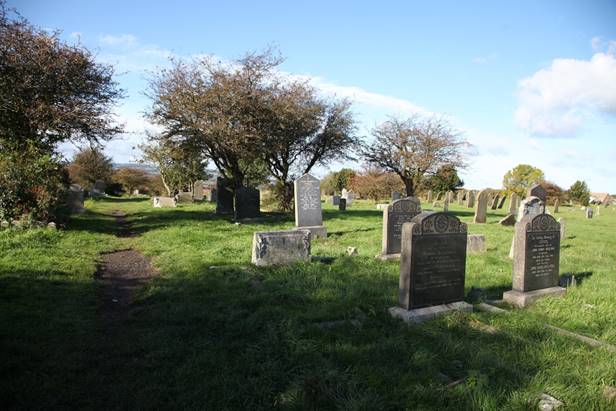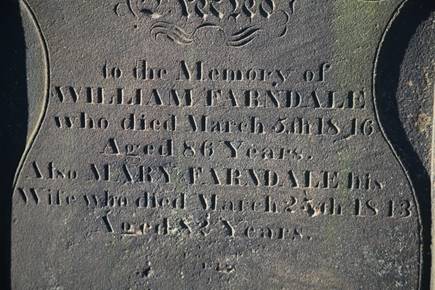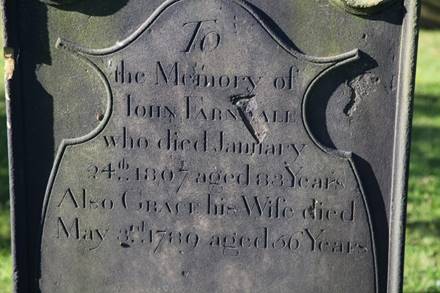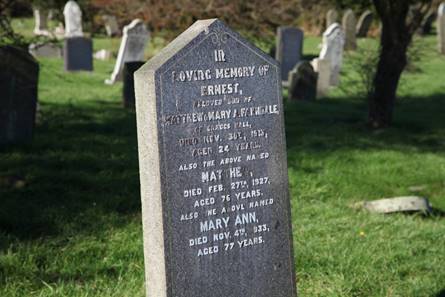|
|
Brotton
A Guide to its History including its associations with the Farndale family
|
|
Introduction
Dates are in red.
Hyperlinks to other pages are in dark blue.
Headlines of the history of Brotton are
in brown.
References and citations are in turquoise.
Contextual history is in purple.
This webpage about Brotton has the following section
headings:
·
The
Farndales of Brotton
·
Brotton,
an overview
·
Brotton
Timeline
·
Buildings
of Brotton
·
People of
Brotton
·
Links
·
Texts and
Books
·
Brotton
Old Churchyard – the Farndale gravestones
The Farndales of Brotton
There are
three lines of Farndales associated with Brotton:
The
Brotton 1 Line were the descendants of Richard ffarndaill
(1650 to 1727) who married Martha Sawer and who was a Yeoman
of Brotton and the first mention of Brotton in the Farndale
ancestry.
The
Brotton 2 Line were the descendants of George Farndale (13 May 1753 to 19
November 1782) who married Mary Stephenson and was the butcher of Brotton.
The
Brotton 3 Line were the descendants of John Farndale (27 October 1772 to 5
July 1833).
Many other Farndales were associated with Brotton, which lies in
the heart of Farndale country. And many Farndales are buried at the Brotton old
cemetery.
Its proximity to Kilton means that the many Farndales who lived at
Kilton saw Brotton as the local town.
Click
here for
the first mention of Brotton in the family records.
Brotton, an overview
In 1923, the parish of Brotton, situated
on the sea coast of Cleveland, included the
townships of Brotton, Kilton and Skinningrove and the
hamlet of Carlin How. It covered 4,262 acres, of which 1,183 acres
were arable land, 294 acres woods and plantations, and 1,720 acres permanent
grass. The chief crops were wheat, beans, barley and
oats. The soil was a strong clay with a subsoil of inferior oolite in Brotton
and Kilton. The highest point in the area was at 500 ft.


1857 Map of Brotton
In the latter half of the nineteenth
century the importance of Brotton was greatly increased by the development of
the mining industry. Between 1861 and 1871 several ironstone mines were
opened in the parish. In 1874 there were five mines at work in the parish:
·
Brotton
mines to the north-west of the village;
·
Kilton
mines further south in Kilton;
·
Cliff
and Huntcliff mines near the coast in Skinningrove,
northwest of the village
·
Craggs
Hall mines, disused by 1923, south-west of Skinningrove.
·
Lumpsey
mine, in the northern part of Kilton near the railway, was opened in 1880.
By 1923, there was a special railway
line for the mines in Kilton, and several public buildings had been opened
in connexion with the miners, such as the Miners' Hospital at Skinningrove,
built by Messrs. Pease & Co. of the Loftus mines in 1871, and an institute
in Skinningrove opened in 1875.
By 1923, Brotton was a large village
built on the western slope of the hill. The High Street, which runs east and
west, was then a continuation of the road from Loftus.
·
In
the centre of the village were the new church of St. Margaret;
the rectory and schools.
·
The
public elementary school in Brotton was built by Messrs. Bell Brothers,
Morrison & Co. and the lessors of the royalties of ironstone in Brotton, and was enlarged in 1895.
·
To
the southeast of the village is the old church of St. Margaret, then serving as
a mortuary chapel.
·
The
Wesleyan Methodist chapel, built before 1855, lies towards the eastern end of
the village.
·
There
were Primitive Methodist and United Methodist chapels and a Salvation Army
meeting room.
·
The
Roman Catholic church, dedicated to St. Anthony of Padua, was built in 1906.
Brotton Hall, near the centre of the village, was
the manor-house. Hunley Hall lay about a quarter of a mile to the north.
The Cleveland Cottage Hospital,
built by Messrs. Bell Brothers in 1874, is at the eastern extremity of the
village.
There was a railway station to
the south-west of the church, on the Saltburn and Whitby branch of the North Eastern railway.
Below the station and due west of the
church lay Brotton Grange. Further north and on the eastern side of the
line was New Brotton, consisting of a few cottages built about 1868.
There was another railway station at Skinningrove. The railway ran through
Carlin How (Carlinghow in the fourteenth to sixteenth
centuries), and a mining hamlet east of Brotton.
(Victoria County History – Yorkshire,
A History of the County of York North Riding: Volume 2 The wapentake of
Langbaurgh (east): Brotton, 1923)
In 2023 Brotton is a village in the
parish of Skelton and Brotton in North
Yorkshire. The local council is Redcar and Cleveland. It is about 4km
south-east of Saltburn-by-the-Sea, and 19km east of Middlesbrough and
23km north-west of Whitby.

The name of the village (known in
medieval times as 'Broctune') means,
"town on the brow of a hill", and is listed in the Domesday Book.
The hill is Warsett Hill. The large Huntcliffe was the site of one of the many Roman signal
stations built along the east coast to defend against Anglo-Saxon attack. The
name has evolved from Bro(c)tune 1086, Brocton 1272, Brotton from
1181. The old English is broc-tun.
In the twenty first century Brotton
became a bit more isolated when a bypass was opened in 1998 between the
villages of Skelton-in-Cleveland and Carlin How.

The discovery of ironstone brought
major changes to the village and a large increase in the population. The majority of former miners' homes are found in the
'Brickyard' and 'the Park' areas of the village.
Brotton village is divided into two
parts: 'Top End' (the area east of the railway line) and 'Bottom End' (the area
to the west).
Brotton Anglican church
is dedicated to St Margaret. Today the village contains a parade of shops on
High Street, and its public houses include The Crown, The Ship,
The Green Tree and The Queen's Arms.
In 2023 Brotton has two primary schools,
Badger Hill Primary School and St Peters Church of
England school. There is also a school for children with learning difficulties,
Kilton Thorpe. The village secondary school, Freebrough Academy, has been rebuilt.
The sculptor Charles Robinson Sykes (1875-1950),
was born in the village. He designed the Spirit of Ecstasy mascot which is used
on Rolls-Royce cars.

Brotton Timeline
2,300 BCE
The Howe Hill Barrow at Brotton, a mile or
so from Skelton, probably dates from about 2,300 BCE. It contained a hollowed
out oak tree, which held the remains of a man.
Saxon England
Before the Norman Conquest, Ucted was the chief landholder in Brotton. Uctred held a
'manor' of 12 carucates in Brotton (Victoria County
History – Yorkshire, A History of the County of York North Riding: Volume 2 The
wapentake of Langbaurgh (east): Brotton, 1923).
1066
The Domesday
Book recorded: “In Broctune (Brotton), 12
carucates for geld, and 6 ploughs can be (there). Uctred had 1 manor there. Now
Richard has (it) of the Count. On the demesne (there is) 1 plough, and (there
are) 8 villeins with 4 ploughs. 12 acres of meadow (are) there. The whole manor
(has) 1 and a half leagues in length and 1 in breadth. T.R.E. it was worth
20s.; now (it is worth) 13s. 4d.To this manor belongs
soc in Mersc (Marske) of 10 carucates for geld, and 5
ploughs to plough (them). 1 villein is there, ploughing with 2 oxen; and 10
acres of meadow.”
1086
By 1086 the manor had passed to the
Count of Mortain, and his tenant was Richard,
referred to in the Domesday Book (Victoria County
History – Yorkshire, A History of the County of York North Riding: Volume 2 The
wapentake of Langbaurgh (east): Brotton, 1923).
Early Landowners
During the reign of Henry
I Brotton became part of the extensive estates of Robert de Brus, Lord of
Skelton.
1272
In 1272 the manor of Brotton passed to
the Thweng family of Kilton Castle. In the division
among the heirs of Peter de Brus in 1272 it passed to Lucy wife of Marmaduke de
Thweng of Kilton Castle (Victoria
County History – Yorkshire, A History of the County of York North Riding:
Volume 2 The wapentake of Langbaurgh (east): Brotton, 1923).
1301
The Lay Subsidy of 1301, showed that for the purposes of this
government tax Brotton was lumped together with Skinningrove and it’s not
possible to tell which taxpayers lived in Brotton and which in its smaller
neighbour. 34 taxpayers were listed. These were mostly heads of families who
had movable property of sufficient value to qualify for paying tax. Historians
reckon that these names represent only about a third or a quarter of the heads
of families, so medieval Brotton must have been quite a sizeable village. The
highest tax was paid by William Latimer, the lord of the manor, at more than 24
shillings. The total for the two villages was just over 73 shillings.
Late fifteenth century to
sixteenth century
The manor must have been conveyed to the
Conyers of Hornby in the late fifteenth century and by the sixteenth century it
was in the hands of the Conyers family (Victoria
County History – Yorkshire, A History of the County of York North Riding:
Volume 2 The wapentake of Langbaurgh (east): Brotton, 1923).
Seventeenth century ownership
In 1641 Conyers Darcy the elder, with
his son Conyers and others, conveyed the manor to William Wiggoner,
who in 1655 made a conveyance of half the manor to Nicholas Wiggoner.
In 1687 Robert Wiggoner held this estate, and in 1697
Timothy Wiggoner, probably his son, and others
conveyed it to John Burdett. Its later history remains obscure, though it may
be this part of the manor which in 1787 was held by William Jackson and his
wife Mary, whose descendants, the Misses Jackson, are landowners here at the
present day.
1653
Parish registers date from this year.
1673
From the returns of the Hearth Tax of 1673 it
appears that Brotton was a sizeable village in the late 17th century. There
were 40 single hearth properties and 9 properties with 2 hearths. Only one
property, that of “Mr Fra Seaton” had 4 hearths. The returns record that a
further 19 single-hearth homes were assessed as below the tax threshold (“The Hearth Tax List for the North Riding of Yorkshire,
Michaelmas 1673, Ripon Historical Society (2011)).
1678
A letter dated from Whitby, 15th
November 1678 (the Calendar of State Papers):
“To-day came some Newcastle men hither, who report that Tuesday last part of
Tynemouth Castle was intended to have been blown up by powder, that 5 of the
contrivers are taken endeavouring to carry on the train, that a ballast man had
several barrels of powder and arms found hid and was fled, that 40 horsemen
armed were heard and seen to march through Skelton and Brotton 16 miles to the
northward of this (town) in the dead of night. On these reports and
apprehensions this town has set a watch to guard our shipping and town, 8
masters of ships each night.” This was after
the English Civil War and the Protectorate and well into the reign of Charles
II.
1778
The medieval chapel of St. Margaret was
rebuilt.
Late eighteenth century
Smuggling was rife at Old Saltburn in
the late eighteenth century and John Farndale wrote: Since the merry days
alluded to the glory of Old Saltburn has departed – its smuggling days have
passed away – its gin vaults have disappeared – and the gay roysterers
who were wont to make Cat Neb and the adjacent rocks resound with laughter, now
rest in peace beneath the green hillocks in the retired grave yards of Brotton
and Skelton.
1801
The Census of 1801 recorded a population of 373 in
Brotton.
1815
There
was a celebration of the Battle of Waterloo, in which John Farndale (FAR00217) took a major role. “After the great
battle of Waterloo, and Buonaparte had been taken prisoner, that glorious event
was celebrated at Brotton by parading his effigy through the street and burning
it before Mr R Stephenson’s hall, amidst the
rejoicings of high and low, rich and poor, who drank and danced to the late
hour. The author formed one of a band of musicians that played on the occasion,
and he composed a song commemorating the event, which became very popular in
that part of the country. Brotton bever before or since saw the like of that
memorable day.”
I am grateful to Dr Tony
Nicholson who has explained that the hall was built by the Stephenson
family in the 1780s after they had made a fortune as woodmongers, trading in
timber as a fuel source, and then when timber became scarce, in coal. With the
money from this trade, Robert bought a third of the manor of Brotton, and then
built ‘Stephenson’s Hall’.
When Robert Stevenson
died in 1825, everything went to his daughter, Mary, who had previously married
Thomas Hutchinson, a master mariner from Guisborough. Mary and Thomas settled
in Stephenson’s Hall which soon became Brotton Hall and over the years they
bought various properties in Brotton.
In The History of Kilton, With a
Sketch of the Neighbouring Villages, By the Returned Emigrant, Dedicated to the
Rev William Jolley, Toronto, Canada, America, Middlesbrough, Burnett &
Hood, “Exchange” Printing Offices, 1870, Redcar Cleveland Library Book No:
R000040114 Classification: 942.854, Book No: R000040114, John Farndale
wrote:
The church has been
greatly improved, new slated roof and a most radical change in the interior;
the old pews and pulpit are all gone, and from the walls Our Fathers’ prayer;
the Belief; the ten commandments, in the xx chapter of Exodus, saying “I am the
Lord thy God which brought thee out of the land of Egypt, out of the house of
bondage; thou shalt have none other gods before me.” Had I not seen those well
known tablets of young Squire Easterby, of Skinngrove Hall, and Wm Tulley , Esy
of Kilton Hall, on beautiful white marble, I should have been at a loss to have
known the old church again. I looked at the place where the old pulpit stood,
and I remembered the ministers that once preached Jesus and the resurrection,
among them my old master, the Rev Wm Barrick, of Lofthouse, - he would descend
from the pulpit and join in the chorus of some twenty voices, 57 years gone,
when I had the happiness to be their chieftain. The parishioners had … most
gladly … and paraded down the mid street at the celebration of the great battle
of Waterloo, and burned before Mr Stephenson’s Hall, when barrels of ale were
given to the frantic multitudes, and the old gentlemen danced and sang until
day break, and here we find young Farndale, once dangling at the mouth of
the well, with his bugle and clarionet, the chief musician to the old
gentleman, and who had also composed the following lines for the occasion –
|
Hail! Ye victorious
heroes, England’s dauntless
saviours, ye Who on the plains of
Waterloo, Won that glorious
victory. |
It was a day the
world may say, When Napoleon boldly
stood, Upon the plains of
the Waterloo, There flowed rivulets
of blood. |
Before the foe he
bravely fought, And when he’d all but
won the day, Would it were night,
or Blucher up, Our hero Wellington
did say. |
But now behold in
effigy, Him to whom kings
such homage paid, Napoleon mounted on a
mule As though he were on
grand parade, Behold with joy all
England sings, Brotton too is up and gay, The band, the flag,
the ball, the dance Ne’er ceased till the
break of day. |
1822
The Topographical
Dictionary of Yorkshire by Thomas Langdale of 1822 described Brotton, in
the parish of Skelton, east division of the wapentake and liberty of Langbaraugh; 6 miles from Guisborough, 14 from Stokesley,
15 from Whitby, population 373.
1840
White’s Directory of 1840 listed 2 shopkeepers, 2 butchers, 2
tailors, 3 shoemakers, 3 blacksmiths, a wheelwright, a painter, a miller and 10
farmers. It also named the Green Tree and the Ship.
1851
The Census
of 1851 recorded a population of 321 in Brotton.
1855
A Wesleyan chapel had opened in Brotton.
1857
Cliff ironstone mine at Huntcliff opened. It closed after thirty years.
1865
Brotton ironstone mine, known locally as
‘Morrison’s mine’, was opened.
1868
Brotton was made a separate parish from
Skelton parish.
1871
The Primitive Methodist schoolroom and
chapel were opened.
Of about this time, John Farndale wrote:
Brotton in this ramble is a retired village, with a very neat church,
pleasantly situated, from the church yard of which there is a lovely prospect
of the vale of Guisbro’ and the fine bay of
Skinningrove. There is a valuable communion service in silver and gold in this
church, presented by one of the Tulleys, and two or
three fine marble tablets decorate the walls. Tindale, the sexton here, an
obliging person, is ever ready to show any visitor the interior.
He also recorded that the local clergy
of Brotton were R Jackson and R Stephenhouse, Esqrs.: chapel of ease, Rev J Perrington – 2 miles.
1872
Huntcliff ironstone mine opened, not far from
Cliff mine.
1874
Cleveland Cottage Hospital was built by Bell
Brothers. It became known as Brotton Cottage Hospital. Martins Bank opened a
branch in Brotton.
1875
Railway passenger services from Brotton
began.
1876
A brass band contest was held in
Brotton.
1880
Lumpsey ironstone mine, just south of Brotton,
began production.
1892
St. Margaret of Antioch, the parish
church of Brotton, was consecrated.
1895
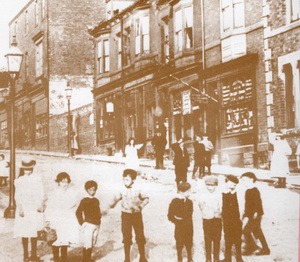
Brotton in about 1895
1897

Brotton High Street in about 1897
1898
The F.A. Amateur Cup semi-final between Middlesbrough
and Thornaby was played at Brotton because of the smallpox epidemic in
Middlesbrough.
1899
Brotton finished fourth in the Northern
Football League Division Two.
1901
The Census
of 1901 recorded a population of 3,323 in Brotton.
Two passenger trains collided near
Brotton station.
1906
St. Anthony of Padua Roman Catholic
church was opened.
Huntcliff mine was closed.
1908
Brotton Temperance Brass Band won the
British Brass Band Association competition.
1909
The Wesleyan Church was dedicated.
1914
The Palace cinema and the Hippodrome
cinema were opened.
During the First World War Lumpsey Mine had a rail-mounted artillery piece to defend
the mine against Zeppelin attack.
Kelly’s Directory of 1914 evidenced that Brotton was bustling,
with 10 grocers, 9 shopkeepers, 2 greengrocers, 5 butchers, 5 drapers, 3
tailors, 4 shoemakers, a chemist, a newsagent, a tobacconist, a watchmaker, a
fancy goods dealer, 2 hairdressers, 2 blacksmiths and 2 joiners. In addition there were 3 beer retailers as well as the Green
Tree, the Ship, the Royal Hotel and the Queen’s Arms.
1916
Zeppelin airships made bombing raids
along the coast.
1921
Production ended at Brotton ironstone
mine.
1923
The Brotton War Memorial was unveiled.
1932
The Hippodrome cinema was destroyed by
fire.
1954
Lumpsey ironstone mine was closed.
Brotton County Modern School was opened.
1960
Brotton station was closed for
passengers.
1962
The official opening of Brotton County
Modern School, which became Warsett School.
1966
The first Skelton and Brotton District
Carnival was held.
1978
Brotton Conservation Area was created.
1985
Kiltondale home was opened. It was demolished in
2011.
1993
The shale tips at Lumpsey
mine were flattened.
1995
A new hospital was built to replace the old
cottage hospital which was converted into homes.
1998
A new road between Skelton and Carlin
How bypassed Brotton.
2001
Warsett School, Brotton, De Brus School,
Skelton and Rosecroft School in Loftus were
amalgamated to form Freebrough College in Brotton.
2006
Brotton Library was moved to Freebrough College.
2011
The Census
of 2011 recorded a population of 7,000 for Brotton Ward.
Buildings of Brotton
Selected Buildings
Brotton Hall (c.1780)
Brotton House (early 19th century)
Hunley House (c.1870)
Brotton station (1875)
St. Margaret’s Church (1891)
St. Anthony’s Roman Catholic Church
(1907)
Cleveland Cottage Hospital (1874)
The Guibal Fanhouse at Huntcliffe Mine
(1872)
East Cleveland Primary Care Hospital
(1995)
Ivy Cottage (17th century) demolished in
1936.
St. Margaret’s old church (18th century)
no longer exists
Brotton Grange (c.1865) on Coach Road no
longer exists
St. Peter’s mortuary chapel (1778)
demolished in 1958.
The Cleveland Hall (c.1870) demolished
in 1984.
The Hippodrome (1914) destroyed by fire
in 1934.
Warsett School (1962) demolished after a fire
in 2005.
People of Brotton
Charles Robinson Sykes (18 December 1875 to 6 June 1950) was a
sculptor from Brotton who designed the Spirit of Ecstasy mascot for Rolls-Royce
cars. He was born in Brotton. Sykes
was commissioned by Lord Montagu to make a special mascot for his 1909
Rolls-Royce Silver Ghost. Sykes produced a small statue of a young woman in
fluttering robes with a forefinger to her lips. It was named "The
Whisper".
Piercy Henderson "Dolly"
Morrison (30 July 1868
to 12 July 1936) was an English rugby union three-quarter who played club rugby
for Northern and Cambridge University and played international rugby for
England in the 1890s. He was born in Brotton to Robert Morrison, a mine owner from Newcastle upon Tyne.
Mary Jarred (9 October 1899 to 12 December 1993)
was an English opera singer of the mid-twentieth century. She was born in
Brotton. She sang at Convent Garden through most of the 1930s and at
Glyndebourne in the 1950s.
John Ronald Murray (born 1924) was a merchant seaman from
Brotton who took part in the D-Day Landings in 1944. For his bravery there he was awarded the
Legion d’Honneur.
Derek McLean (born 21 December 1932) was a
footballer from Brotton who played for Middlesbrough in the 1955-56 season and
for Hartlepool United. He played alongside the future international players
Brian Clough, Alan Peacock and Edwin Holliday.
David (“Dave”) William Charlton (27 October 1936 – 24 February 2013)
was a racing driver. He was born in Brotton but moved to South Africa where he
became the country’s leading formula one racing car driver in the 1970s. He
participated in 13 World Championship Formula One Grands Prix, debuting on 1
January 1965. He scored no championship points. He competed in many non-World
Championship Formula One races, winning the South African Formula One
Championship six times in succession from 1970 to 1975.
Links
https://www.facebook.com/groups/brottonhistoryphotos/
Cleveland
& Teeside Local History Society entry on Brotton.
Texts and Books
“A Guide to Saltburn-by-the-Sea and
the Surrounding District” J. Farndale (1864)
“East Cleveland Photographic Memories”
R.Darnton (2010)
“Know Your Parish: Brotton” M.Wall, C.F.H.S. Journal vol.3 no.
7 (1987)
Brotton Old Churchyard
The Farndale gravestones in Old Brotton
cemetery in 2016:







